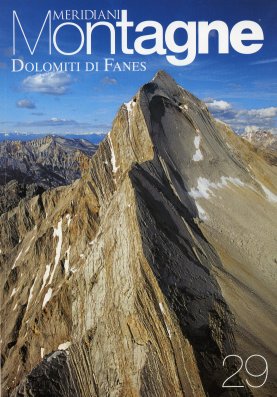|
November,
2007
The
November issue of the magazine "Meridiani Montagne"
(Meridians, Mountains)
is
totally devoted to the Dolomiti of Fanes, with a hint to their
legends.
"Meridiani
Montagne", for those who don't know it, is an Italian
magazine whose monthly issues are devoted each to a single mountain,
or a group of mountains, usually chosen within the crown of the
Alps.
Our
friend Norbert Spina alerted me that issue n.°29, Nov. 2007,
deals with the Dolomites of Fanes.
|
The
lion's share is taken by itineraries: hiking, climbing,
mountain biking etc., always very clearly described and
documented. There are a lot of wonderful photos. But there
are also articles devoted to every natural and cultural
aspect related to the mountains, including local cuisine
and, in our case, legends.
The enclosed map, scaled 1:25,000, is somewhat simplified
but, for this same reason, appears very clear and easy to
read. Unfortunately, it doesn't stretch south enough to
cover the Lagazuoi and even the peaks of Fanes and most
of the Alpe di Fanes grande. Printing requirements,
I guess, but the map's usefulness, at least for my own usage,
gets significantly reduced.
The
section devoted to legends is entrusted to Marina
Morpurgo, a clever journalist who is a fan of mountaineering,
and in her spare time writes charming fables for children.
Maybe because of this "specialization" of her,
the writer deals with the Fanes' legend as if it were a
fable, not realizing that the morphology of the tale is
completely different (by the way, in the Ladinian tradition,
real fables can be seldom found, and most of them are imported).
She approaches the topic by confining the Fanes into an
escapeless dreamworld and - in my honest opinion - doesn't
even scratch the real core of the problem.
|
 |
I'm
also quite puzzled at the statement that the character of the
wildman, widely spread
in the folklore of at least one half of Europe, be known as "...
Salvanel in the Ladinian valleys and (not by chance)
Fanes in the Badia valley." This way, the conspicuous
structural differences among the quoted characters are completely
overlooked, although the Salvan (this one being the true
Ladinian equivalent of the wildman) is mentioned not only by Wolff,
but also by Alton, De
Rossi and others.
In any case I truly
appreciated that Marina Morpurgo quoted in her writing both this
site - and I thank her for that - and that of Susy Rottonara's
Associazione
Culturale Fanes.
Finally, we can find
a hint to the "stone king's" head near the Falzarego
pass, a third instance of which is proposed: I'm commenting on
it in a few lines I added to the former news,
where I pointed out having retrieved the second one.
To summarize, I believe
that this issue of Meridiani Montagne is anyway a must
for everyone who is interested at the Fanes, or more generally
loves their wonderful mountains.
|

